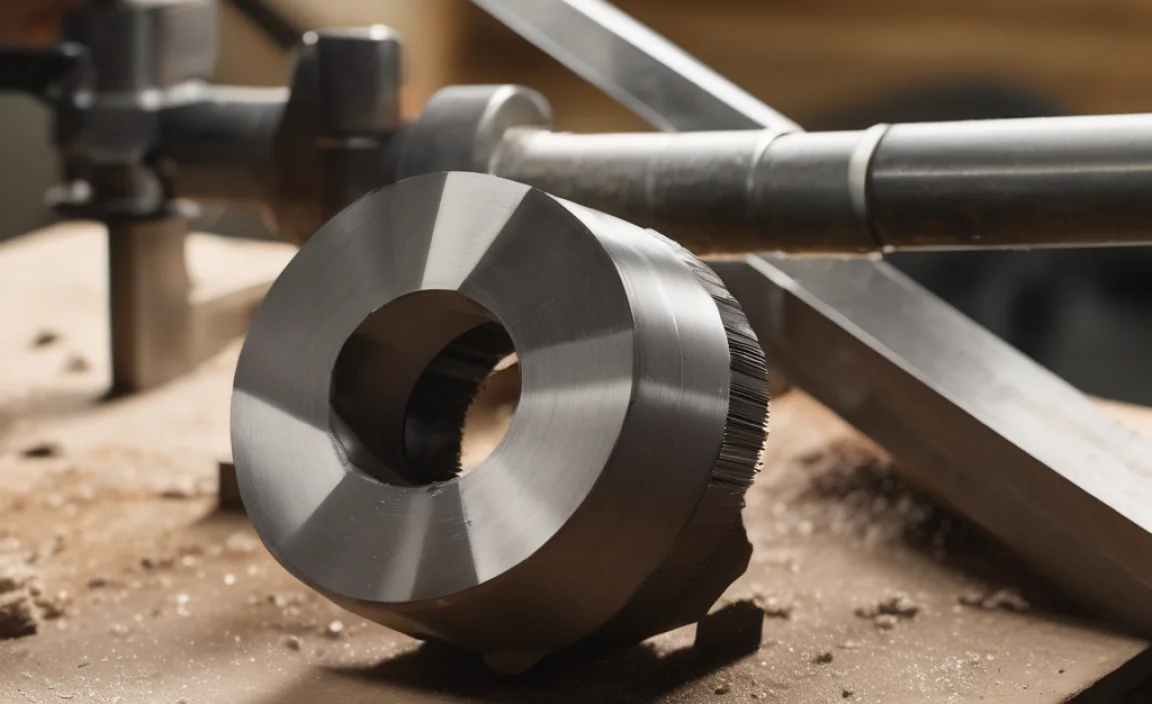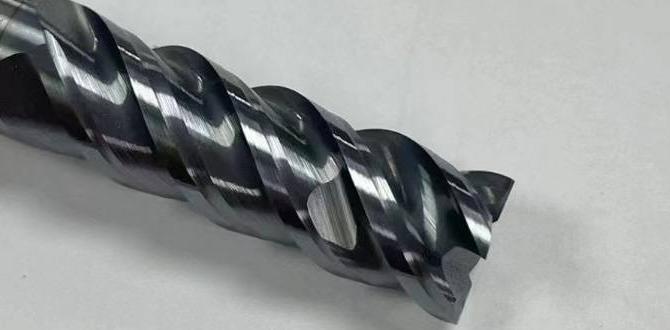Quick Summary:
The Tialn ball nose end mill with a 55-degree helix angle is a fantastic tool for clearing PVC. Its design helps prevent melting and clogging, leading to cleaner cuts and extended tool life. This guide shows you how to use it effectively for smooth PVC machining.
Mastering PVC Machining: The Tialn Ball Nose End Mill 55 Degree Secret
Working with plastics like PVC on a milling machine can sometimes feel tricky. One common frustration is material buildup, often called “chip welding” or clogging, which can leave messy surfaces and even damage your tools. But what if there was a simple, effective solution that makes clearing out those challenging pockets a breeze? Meet the Tialn ball nose end mill with a 55-degree helix angle.
This specialized tool is a game-changer for anyone tackling PVC. Its unique design allows it to shear through the plastic cleanly, dramatically reducing the melting and sticking that plague other end mills. In this guide, we’ll walk you through exactly why this end mill is so good for PVC and how you can use it to achieve amazing results in your workshop. Get ready to leave those frustrating clogs behind!
Why PVC Machining Can Be a Challenge
PVC, or polyvinyl chloride, is a popular plastic for many projects, from plumbing to custom decorative pieces. Its affordability and ease of use make it attractive. However, when it comes to machining, PVC presents a unique set of challenges, primarily due to its thermal properties.
Low Melting Point: PVC has a relatively low melting point compared to many metals. This means that as a cutting tool spins and creates friction, the heat generated can quickly cause the PVC to soften and melt.
Chip Welding: The melted PVC can stick to the cutting edges of the end mill. This phenomenon is known as chip welding. As more material welds onto the tool, it becomes duller, less effective, and can lead to poor surface finishes and increased stress on the machine.
Aggressive Cutting: Standard end mills, designed for metal, can sometimes cut PVC too aggressively. This can lead to vibrations, chatter, and further heat buildup, exacerbating the melting issue.
Dust and Fumes: Machining PVC also produces dust, and depending on the type and speed, potentially harmful fumes. Proper ventilation and safety precautions are essential.
These issues can make clearing pockets, cutting intricate shapes, or even just taking consistent passes frustrating for beginners. You might find yourself constantly stopping to clean the tool, dealing with rough edges, or even breaking bits.
Introducing the Tialn Ball Nose End Mill 55 Degree
This is where the Tialn ball nose end mill with a 55-degree helix angle shines. Let’s break down what makes it special for PVC:
Ball Nose Design: The rounded, ball-shaped tip of a ball nose end mill is excellent for creating smooth, contoured surfaces and fully clearing out pockets. Unlike a square end mill, it can reach the very bottom corners, essential for many designs.
55-Degree Helix Angle: The helix angle refers to the spiral of the cutting flutes. A 55-degree helix angle on this Tialn end mill is specifically designed for softer materials like plastics.
Shearing Action: This angle provides a more gentle, sweeping shearing action rather than a direct chipping action. Think of it like a sharp knife smoothly slicing through material rather than a hammer breaking it. This reduces heat generation significantly.
Improved Chip Evacuation: The specific flute design with a 55-degree helix promotes better chip evacuation. This means the plastic chips are more likely to be thrown away from the cutting edge and out of the flume, preventing them from building up and melting.
Tialn Coating: While less common on tools specifically marketed for plastics, some high-performance end mills might feature specialized coatings. Tialn (Titanium Aluminum Nitride) is a hard, wear-resistant coating typically used for high-speed machining of metals. If a Tialn-coated end mill is used for PVC, its primary benefit might be extended tool life through increased hardness, although its main advantage is usually in metal. For PVC, the helix angle and ball nose become the stars of the show. The key is that the geometry is optimized for plastics even if a coating is present.
By combining these features, the Tialn ball nose end mill with a 55-degree helix angle offers a superior solution for predictable and clean PVC machining.
How to Use Your Tialn Ball Nose End Mill for PVC Clearing (Step-by-Step)
Using any cutting tool effectively involves more than just putting it in the collet. Here’s how to get the best performance out of your 55-degree ball nose end mill when clearing PVC:
Step 1: Machine Setup and Safety First!
Safety is paramount in any workshop. Before you even think about turning on the machine, ensure you’re prepared.
Personal Protective Equipment (PPE): Always wear safety glasses or a face shield. While PVC might not produce flying metal shards, plastic chips can be sharp and ejected at force. Consider wearing hearing protection, especially if your machine is loud.
Ventilation: Work in a well-ventilated area. PVC can release fumes, especially when heated. An exhaust system or open windows are crucial.
Secure Workpiece: Clamp your PVC firmly to the milling machine table. Use appropriate clamps and ensure there are no loose edges that could be caught by the spinning tool.
Machine Check: Make sure your milling machine is in good working order, with no loose belts or vibrating components.
Step 2: Secure the End Mill
Use the Correct Collet: Select the collet that precisely matches the shank diameter of your Tialn ball nose end mill. A loose fit can lead to runout and poor cutting performance.
Insert the End Mill: Insert the end mill into the collet, ensuring it’s seated firmly. Don’t push it in too deep – you want enough shank engaged for stability, but not so much that it interferes with the workpiece. The flutes should be accessible for cutting.
Tighten the Collet: Tighten the collet securely using your collet wrench. Ensure it’s snug but avoid overtightening, which can damage the collet or the end mill shank.
Step 3: Setting Spindle Speed and Feed Rate (Crucial for Plastics!)
This is one of the most critical steps when machining plastic. Getting these parameters right will make all the difference.
Spindle Speed (RPM): Plastics need to be cut at different speeds than metals. Generally, you’ll want a higher spindle speed for plastics. For PVC and a 1/4″ or 1/2″ ball nose end mill, speeds between 6,000 and 15,000 RPM are a good starting point. The exact speed will depend on the diameter of your end mill and the specific type of PVC.
Why? Higher RPM at a controlled feed rate helps the end mill cut cleanly and shear the material rather than rubbing and generating excessive heat.
Feed Rate (IPM or mm/min): The feed rate is how fast the tool moves through the material. For PVC, you need a fast enough feed rate to avoid melting but slow enough to allow for clean cuts without excessive vibration. A good starting range for many ball nose end mills in PVC could be 20-60 Inches Per Minute (IPM).
Why? A feed rate that’s too slow will cause the end mill to linger in the material, generating heat and leading to melting. A feed rate that’s too fast can cause the tool to chatter, break, or result in a poor surface finish due to insufficient chip formation.
Finding the Right Settings:
It’s always best to consult the end mill manufacturer’s recommendations if available. If not, start at the lower end of the recommended RPM and IPM ranges and gradually increase them while observing the cut. Listen for the sound of the cut; a smooth, consistent sound is good. Screeching or a high-pitched whine might indicate you’re feeding too fast or too slow.
You can find general machining calculators online that can help you estimate these parameters. For example, the United States Department of Labor’s Occupational Safety and Health Administration (OSHA) provides resources on machinery safety, and various machining forums and reputable tool manufacturers offer guides.
Step 4: Setting the Depth of Cut
Consider “Adaptive Clearing” Strategies: For clearing out large pockets, adaptive clearing toolpaths are highly recommended. These strategies use a high-speed, a-centric motion to engage the material in a way that hugs the wall of the pocket, reducing heat and chip load. Most CAM software (like Fusion 360, Mastercam, VCarve) offers adaptive clearing toolpaths. If you’re programming manually or using simpler software, you’ll be taking conventional passes.
Light Passes are Key: For PVC, it’s much better to take several light passes rather than one deep pass. A depth of cut between 0.050″ to 0.250″ (1.2mm to 6mm) is often a good starting point, depending on your end mill diameter and machine rigidity.
Why? Deep cuts increase the material engagement and friction, leading to more heat and melting. Light passes allow the 55-degree helix to do its job efficiently, shearing the material with less heat buildup.
Step 5: Executing the Cut
Plunge Carefully: When plunging the end mill into the material, do so slowly. Some end mills are designed for plunging (“slotting”), but it’s always good practice with PVC.
Observe the Cut: Pay close attention as the end mill cuts. Listen for any unusual noises. Watch the chips being produced – they should be relatively small and appear to be ejected cleanly. If you see melted plastic sticking to the flutes or the workpiece surface, you may need to adjust your speed, feed, or depth of cut.
Cooling (Optional but Recommended): While the 55-degree helix helps, using a coolant or a blast of compressed air aimed at the cutting zone can further reduce heat and improve chip evacuation. For PVC, a simple air blast is often sufficient. Avoid liquid coolants that might react with the plastic or create a slippery mess.
Step 6: Clearing Toolpaths and “Adaptive Clearing” Explained
The concept of clearing out material from a pocket is where the ball nose end mill truly excels, especially when combined with an “adaptive clearing” strategy.
Traditional Pocketing: With traditional pocketing, you might make back-and-forth passes, which can leave a lot of material near the walls and corners. This can lead to increased tool pressure and heat.
Adaptive Clearing: This sophisticated toolpath strategy uses large, trochoidal (circular) movements to continuously engage the wall of the pocket.
Benefits for PVC:
Reduced Heat: By maintaining a consistent, relatively small depth of cut and a high-speed engagement with the material, heat buildup is minimized.
Better Chip Evacuation: The sweeping motion of the toolpath helps push chips away from the cutting zone.
Less Tool Wear: Reduced heat and force mean your end mill lasts longer.
Smoother Surface Finish: You often get a much cleaner and more consistent surface finish.
Most modern CAM software packages offer adaptive clearing or similar high-efficiency toolpaths. If you’re new to CAM, exploring these options can significantly improve your machining results for plastics.
Maintaining Your End Mill and Machine
Even with the best tools and techniques, proper maintenance ensures longevity.
Cleanliness: After machining PVC, clean your end mill thoroughly. A soft brush and some plastic-safe solvent (like denatured alcohol) can remove any minor residue. Check the flutes for any signs of buildup.
Inspect for Damage: Periodically inspect your end mill for any chipped teeth or excessive wear. A dull or damaged end mill will perform poorly and can be a safety hazard.
Machine Bed and Ways: Keep your milling machine clean. Removing plastic dust and chips from the ways (the guiding surfaces) and the machine bed prevents premature wear. Lubricate as per your machine’s manual.
When to Use a Different Tool for PVC
While the Tialn 55-degree ball nose is fantastic for clearing and general pocketing, it’s not the only tool you might need.
Roughing: For very large areas where high material removal rates are needed, a standard, larger-diameter end mill might be used in conjunction with a ball nose for finishing. However, for PVC, the risk of melting with standard roughers is high. Many machinists opt for high-efficiency roughing passes with specialized tooling if substantial material needs to be removed quickly.
Finishing: For extremely smooth surface finishes on flat surfaces, a flat-bottomed end mill might be selected for the final pass. However, the ball nose naturally creates a radiused corner, which is often desirable. The 55-degree helix helps ensure this finishing pass is clean.
Sharp Edges: If you need perfectly square corners in a pocket (which is rare in plastic machining as most applications don’t require it), you would use a square end mill.
Potential Issues and Troubleshooting
Even with the best tool, you might encounter a hiccup.
Melting and Clogging:
Solution: Increase spindle speed (RPM), increase feed rate (IPM), reduce depth of cut, improve chip evacuation (air blast), or try a different grade of PVC.
Chatter (Vibration):
Solution: Ensure the workpiece is rigidly clamped, reduce depth of cut, ensure the end mill is seated correctly in the collet, check for any play in the spindle or machine components.
Poor Surface Finish:
Solution: Ensure spindle speed and feed rate are optimized, check for end mill wear, ensure rigidity and proper clamping.
A Comparison: Helix Angles for Plastics
The 55-degree helix angle stands out for plastics, but why? Let’s look at common helix angles and their implications:
| Helix Angle | Typical Use Case | Pros for Plastics | Cons for Plastics |
|---|---|---|---|
| 30 Degrees | Soft plastics, aluminum, general engraving. | Very gentle shear, good for shallow cuts and preventing melting. Can produce very fine surface finishes. | Lower material removal rate, can wander more easily. Not ideal for deep pocketing. |
| 45 Degrees | Plastics, aluminum, copper alloys. A good all-rounder. | A balance of shear and rigidity. Better chip evacuation than very low angles. | Can still generate moderate heat compared to 55 degrees. |
| 55 Degrees | Optimized for plastics like PVC, ABS, acrylics, and some softer metals like aluminum. | Optimal shearing action, vastly improved chip evacuation, significantly reduced heat generation. Ideal for pocketing and adaptive clearing. | Slightly less rigid than higher helix angles, might not be the best for very aggressive roughing in harder materials. |
| 60+ Degrees | Steel, stainless steel, harder metals. High rigidity. | Excellent rigidity and strength for aggressive metal cutting. | Too aggressive for most plastics, will cause excessive heat, melting, and potentially tool breakage. Lacks the necessary shearing action. |
As you can see, the 55-degree helix angle is specifically engineered to provide the best balance of cutting action and heat management for materials like PVC.
Resources for Further Learning
To deepen your understanding of machining plastics, consider these excellent resources:
Plastics Industry Association: They offer insights into the properties and fabrication of various plastics. (plasticsindustry.org)
Machining Forums and Communities: Websites like Practical Machinist or Home Shop Machinist have active communities where you can ask questions and learn from experienced users.
Tool Manufacturer Data Sheets: Reputable tool manufacturers often publish cutting data and application guides for their end mills. Look for resources from companies like Sandvik Coromant, Iscar, Kennametal, or specialized plastic tooling suppliers.
* CAM Software Documentation: If you use CAM software, read its documentation on adaptive clearing and other high-efficiency toolpaths.
Frequently Asked Questions about Tialn Ball Nose End Mills for PVC
What is the best spindle speed for a 55-degree ball nose end mill in PVC?
A good starting range for PVC is typically 6,000 to 15,000 RPM. Always start conservatively and test, adjusting based on the sound of the cut and the chips produced. The exact speed depends on the end mill diameter and the specific PVC formulation.
Can I use a Tialn ball nose end mill on other plastics?
Yes, the 55-degree helix angle is excellent for many plastics, including ABS, acrylics, polycarbonate, and HDPE. Its ability to shear cleanly and reduce heat makes it versatile for a range of plastic materials.
What is “chip welding” and how does this end mill prevent it?
Chip welding is when the plastic melts and sticks to the cutting edges of the end mill. The 55-degree helix angle provides a gentler shearing action that generates less heat, and its flute design helps clear chips away from the cutting zone more effectively, preventing them from melting and accumulating.
Do I need coolant when machining PVC with this end mill?
While not always mandatory, a blast of compressed air directed at the cutting zone is highly recommended. It helps cool the cutting edge and evacuate chips. For most PVC applications, liquid coolant is often unnecessary







